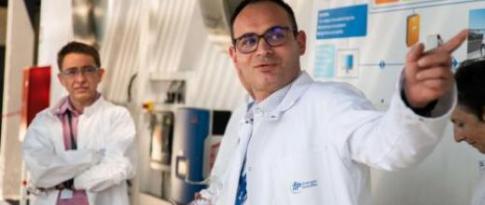13.11.2020
6 minutes of reading
A year after its launch, the CARMEN joint research laboratory (JRL) took the opportunity to conduct an initial review of progress and define its future program at a meeting of the steering committee held on 8 July 2020. Despite the impact of COVID, the JRL enjoyed a successful debut year both scientifically and in human terms.
The joint laboratory was launched on 1 March 2019 for a period of five years to conduct in-depth studies of mesoporous or lamellar substrates. These materials are of considerable interest for the energy transition since they have many applications, notably in the fields of biomass catalytic conversion, adsorbents for contaminant reduction and renewable energy storage.
A coherent consortium: 40 researchers, one scientific project
The JRL’s program is an ambitious one: the objectives are the multi-scale characterization of the structure of these materials, particularly in operando conditions, as well as the identification of the relationship with their transport properties. The type of materials (boehmite, clays, zeolites) and research themes concerned required the creation of a consortium with multiple and complementary expertise. IFPEN thus joined forces with several academic partners in France: Anne Lesage’s team at the CRMN (high-field nuclear magnetic resonance spectroscopy center in Lyon) supervised by the CNRS, the team from ENS Lyon and Claude Bernard Lyon 1 University, Pierre Levitz’ team at the PHENIX laboratory supervised by the CNRS and Sorbonne University, and, finally, Ovidiu Ersen’s team at the IPCMS (Strasbourg Institute for materials physics and chemistry) supervised by the CNRS and Strasbourg University.
40 researchers from five different sites are involved, which represents something of an operational challenge. Managed using a collaborative approach, partner teams began their work and intensified their exchanges, resulting in the consolidation of the consortium and the reinforcement of overall coherence and the scientific project as a whole. This high-quality scientific approach has already led to the transfer of the first results.
Transformation of boehmite: the first 3D imaging results
One of the themes studied by the JRL concerns lamellar materials, particularly boehmite pastes, the structure of which remains poorly understood on large scales. When it is calcined, this material is converted into alumina, an essential catalyst support used in heterogeneous catalysis in the refining sector. Hence the importance of understanding its structural evolution, from suspension to extrudate.
In fact, having studied the densification of boehmite suspensions by combining DLS (dynamic light scattering) and SAXS (small-angle x-ray scattering) approaches, which are characterization techniques making it possible to obtain data on a global scale, research teams produced different boehmite suspensions based on protocols developed upstream by IFPEN, resulting in the validation of a standard suspension.
The structure of boehmite pastes was also the focus of a multi-scale 3D study of its morphology and texturing through the various alumina preparation steps, giving rise to a first reconstruction of the three-dimensional structure of a standard sample.
Porous system reconstruction method: 3 supporting imaging surveys
The JRL is also studying charged lamellar materials, such as clays. The understanding of molecular and/or colloidal transport in porous media is a prerequisite, particularly in the pollution remediation sector. The JRL is not attempting the highly complex study of natural soils but its research teams have, instead, laid the necessary groundwork for the development of a method for preparing mixed porous media yet to be defined.
To do so, reconstituted systems of clay and silica particles of variable sizes were the focus of a multi-scale geometric study based on three imaging surveys - TEM (transmission electron microscopy), SAXS and SOLEIL’s Anatomix beamline (dedicated to X-ray tomography, on a micro and nanometric scale) - in order to establish several preparation protocols. The latter are now being used either to combine clay grains with silica grains, or generate silica coatings involving a clay cap.
Zeolite: illuminating publications upstream of modeling
Lastly, to obtain highly active catalysts in refining, petrochemical, pollution remediation and biomass conversion processes, the JRL plans to study and monitor the morphological and structural transformation of mesoporous materials, such as zeolites, during industrial processing.
In this field, the JRL has primarily focused on preparing future modeling projects. Publications by Céline Chizallet, in particular, were useful for furthering the state of the art on the subject: one publication focused on the results of a theoretical zeolite modeling study concerning the development, using density-functional theory (DFT), of models of the external surface of the ZSM-5 zeolite, and another related to the modeling of complex zeolite catalysts.
Four projects were also submitted to the ANR, one of which successfully completed the 1st selection phase. These early advances, achieved despite the context of the pandemic, augur well for promising developments.
Scientific contact : Nathalie Schildknecht
You may also be interested in
CARMEN focuses on energy transition materials
To support the development of innovations for the energy transition, the CNRS, École Normale Supérieure Lyon, IFPEN, Sorbonne University, Claude Bernard
CARMEN focuses on energy transition materials
To support the development of innovations for the energy transition, the CNRS, École Normale Supérieure Lyon, IFPEN, Sorbonne University, Claude Bernard






